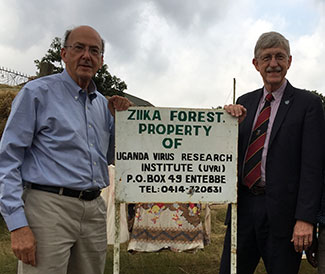NIH weighs new opportunities in global health research
November / December 2018 | Volume 17, Number 6
Opinion by Fogarty Director Dr Roger I Glass
“A good hockey player plays where the puck is. A great hockey player plays where the puck is going to be.” That sentiment attributed to sports legend Wayne Gretzky has been on my mind lately.
Here at Fogarty, we’ve spent the past year considering what the Center has accomplished since its
founding 50 years ago and how we should be positioning ourselves to take advantage of the new frontiers of global health science, emerging technologies and other opportunities to ensure we and our community are prepared to speed discoveries that improve health.

NIH Director Dr. Francis S. Collins is guiding development of
a new trans-NIH research agenda for global health.
In the last few months I’ve led several consultations with my NIH peers and collaborators to brainstorm together how we can have the greatest impact in the coming decade. I’m fortunate that Dr. Francis S. Collins remains as NIH Director, and is encouraging these efforts, with
global health research as one of his top priorities. With his guidance, we’re considering a number of possible activities.
One significant strand that has emerged in our discussions is to consider how we can better leverage technologies to improve diagnoses and treatment of disease in low- and middle-income countries (LMICs), where there’s a shortage of health care workers with advanced training. New tools could be developed or adapted to put simple diagnostics, treatments, telemedicine consultations and other mobile interventions and novel devices in the hands of clinical officers, nurses and community health workers. That could lead to earlier detection of disease, simpler treatments, improved adherence to care, and better health outcomes - all while decreasing the cost of care. An added bonus is that concepts developed in these low-resource settings could have relevance back in the U.S., as we work to improve care while cutting costs.
Building data science capacity was another priority area that received strong endorsement. It will benefit the global research community at large if LMIC scientists are well-prepared to participate in the “Big Data” revolution. As more developing countries establish disease registries, biobanks and electronic medical records systems, it will become increasingly important to ensure data quality and interoperability with the broader scientific community.
It was also suggested that an international meeting be convened to consider how best to leverage the existing LMIC research infrastructure established with funding for HIV/AIDS and other infectious disease studies, as well as through the
Medical Education Partnership Initiative (MEPI) and the
Human Heredity and Health in Africa (H3Africa) program. In addition, we might consider the demographic trends in the U.S. as we plan strategic research investments globally, for instance expanding research in Central and South America.
These and other ideas mean it’s an exciting time at NIH, as we contemplate future directions. As research becomes more complex, it will be important for us to continue to expand multidisciplinary research partnerships, to nurture collaborations among engineers, physician-scientists, business experts and more. We must cultivate an ecosystem for innovation in LMICs and find new ways to harness affordable technologies to improve health. By working together on all these fronts, we can score many goals for global health.
More Information
To view Adobe PDF files,
download current, free accessible plug-ins from Adobe's website.